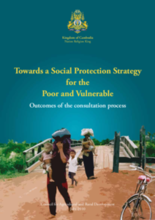This Note provides background and technical information on social protection in Cambodia to inform the development of a national social protection strategy for the poor and vulnerable by the Council for Agricultural and Rural Development (CARD). This document is the outcome of over a year-long consultation process in which CARD, in collaboration with the Interim Working Group on Social Safety Nets under the Technical Working Group on Food Security and Nutrition (TWG FSN), convened several technical consultations and meetings and produced policy notes discussing selected aspects of a social protection strategy for the poor and vulnerable to build consensus on the meaning of key concepts and the broad direction for policy development.
The Note reviews risks and shocks faced by the poor and vulnerable and matches them with coverage of existing programs to identify gaps and challenges in existing interventions. The risks and shocks analyzed can be grouped into: situations of emergency and crises, such as natural disasters and economic crises (with outcomes including reduction in purchasing power, increase in food insecurity, reduced earnings, rise in underemployment and unemployment, increase in insecure and risky employment and destruction/degradation of assets and resources); human development constraints (leading to poor maternal and child health and nutrition, high school dropout rates, low levels of skills attainment and increased incidence of hazardous and unconditional worst forms of child labor); seasonal unemployment and income insecurity (leading to poor health and nutrition and decreased capacity to study or work productively); and health shocks (leading to higher mortality rates and loss of assets and increased debts). In addition, there are special vulnerable groups (for example the elderly, people living with disabilities, people living with chronic illness, ethnic minorities) who are identified as warranting strengthened social protection and/or specific types of intervention. The Note then reviews existing programs that aim to provide social protection for the vulnerable population and identifies gaps with regard to coverage of risks, coordination, monitoring and evaluation, financing and targeting of interventions.
In order to address outstanding gaps and challenges, this document provides options for the future that aim at expanding and harmonizing some existing interventions, as well as options suggesting additional programs to reach those most in need. Social health protection (e.g. health equity funds (HEFs), community-based health insurance (CBHI)), promotion of education and child development (e.g. scholarships for the poor, school feeding, take-home rations), fortified food transfer and public works (e.g. food for work and cash for work) are among the programs that can benefit from expansion, harmonization and improvements in their current design. The Note also proposes the development of a cash transfer program to alleviate chronic poverty and promote human development as a new option for the near future, along with programs that promote skills development for out-of-school youth.
In addition to program options, proposals on how to better address elements of implementation such as coordination, financing and targeting are also included. Among others, capacity building within CARD in the near future is needed in order to achieve effective coordination, monitoring and evaluation of social protection interventions. How sustainable financing becomes in the future is reliant on the extent to which the Royal Government of Cambodia (RGC) gradually increases ownership and financial commitment to social protection programs. And the main targeting mechanism, which is increasingly being adopted, the Identification of Poor Households program (IDPoor), can benefit from guaranteed medium-term financing and further evaluation to enhance its accuracy. Complementary targeting instruments could also be considered in certain cases, especially to reach special vulnerable groups.

